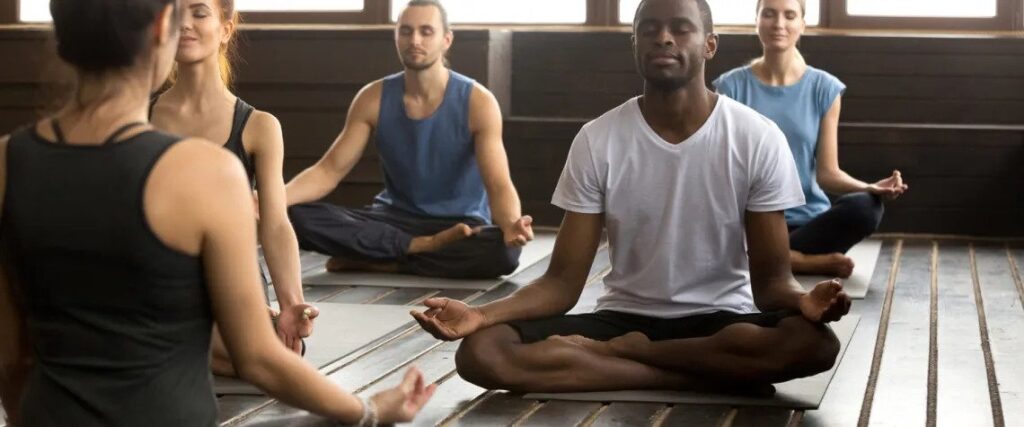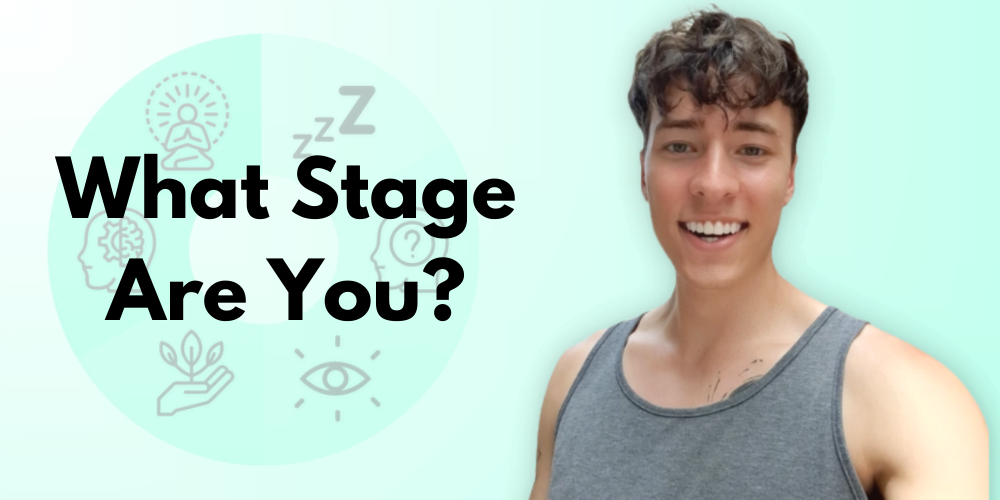
Guided meditation has been shown to provide numerous benefits, such as reducing stress, improving sleep, and boosting mental clarity. However, leading a great guided meditation can be challenging, especially if you’re new to this practice.
It’s hard to know exactly what to do for your first time leading a guided meditation and the endeavor can be quite nerve wracking. Even the experienced meditation instructor has more they can add to their routine to improve a meditation.
Whether you’re leading a group of people or guiding someone through a personal meditation, here are a few key steps you can take to make the experience as effective and enjoyable as possible.
8 Steps for a great guided meditation
1. Set the stage
Before beginning the meditation, make sure the space is quiet, comfortable, and conducive to relaxation. Turn off electronic devices, dim the lights, and play soft, calming music if desired.
Check out my meditation playlist on Spotify for your next meditation class here.
Meet your students with a smile as they enter the meditation space. Introduce yourself to the class and welcome them to your class or session.
Encourage participants to find a comfortable seat and close their eyes. If you’re leading a group meditation, make sure everyone has enough space.
Reassure your participants that there is no right or wrong way to meditate and that they may sit or lay in whatever position is most comfortable to them.
Your calm and low pressure attitude will allow your participants to begin relaxing as soon as they walk in.
2. Start with deep breathing
Begin the meditation by having participants focus on their breath. Ask them to inhale deeply, hold their breath for a few seconds, and then exhale slowly.
Repeat this breathing exercise several times, encouraging participants to focus their attention solely on their breath. This deep breathing exercise will help them to relax and prepare their minds for the meditation.
You may also ask participants to breath in specific intervals such as the 4-4-4 method that includes breathing in for 4 seconds, holding the breath for another 4 seconds, and exhaling for out for a final 4 seconds. This method can be repeated as many times as you like and can be modified for longer or shorter inhalations and exhalations.
3. Lead a body scan to relax the muscles
When leading a guided meditation, it’s important to have the participants physically relax as much as possible. Remember that the mind follows the body, so if your body is tense your mind will find it hard to unwind.
Begin leading the body scan from either the top of the head or the tips of the toes and work your way either up or down the body depending on where you started:
- Start at either the top of the head or tips of the toes
- Focus their attention on one body part at a time
- Have them notice any sensations in each section as you move up or down the body
- Notice any muscle tension in the area being focused on and encourage meditators to relax all muscles in that area
- At the end of the scan quickly go through the body once more to find any tense muscles to relax
Take your time during this portion to really make sure your participants are releasing all the tension stored in their bodies. You can take as long or little as you want for this section. I’d recommend giving this section at least 5 minutes, though 8-10 minutes will be more effective especially for longer meditations.
4. Use imagery and visualization techniques

One of the most effective techniques in guided meditation is visualization. Encourage participants to create vivid images in their minds, such as a peaceful beach or a lush green forest. Ask them to focus on these images and use their imagination to create a sense of peacefulness and relaxation.
You can also guide participants through specific visualization exercises, such as:
- Imagining their stress and anxiety melting away
- Picturing a bright light surrounding them
- Imagining a stream of cleansing light piercing through them
Visualizations can be a powerful way to get the thinking mind to calm down and focus in a more beneficial way.
5. Encourage self-reflection
Encourage self-reflection during the meditation. Encourage participants to reflect on their thoughts and feelings. Ask them to focus on their physical sensations, such as their breath and heartbeat, and to observe their thoughts without judgment. This self-reflection can help them to develop a deeper understanding of their own emotions and improve their ability to manage stress.
This is also a great time to ask deep questions. Give your participants a reflective question meditate on such as:
“Where in your life do you feel the most joy?”
“Where in your life do you feel the most stress?”
“What could you let go of in your life right now?”
Asking these kinds of questions allow for a guided meditation to get more personal, intimate, and deeper than your average mindfulness meditation session.
Check out Positive Psychology’s top self reflection questions here.
6. Allow for a period of silent and solo meditation

It’s important to include a period of solo meditation time during a guided session. Encourage participants to do whatever feels most comfortable in these silent periods. This may be meditating, napping, stretching, or whatever feels right to them in this silent time.
Silent periods should be included for at least 5 minutes at the end of your guided meditation, however can be extended much longer depending on the length of the meditation session.
7. Ending the meditation
End the meditation by encouraging participants to come back to their senses. Have them wiggle their fingers and toes to awaken their bodies. Lead them through a quick stretch to get them out of their meditative state.
Have participants open their eyes whenever they’re ready and sit up at their own pace.
Don’t rush meditators in this process, rather let them come back at a slow pace that works best for them.
8. Follow up with participants
After the meditation, make sure to follow up with participants. Ask them how they felt during the meditation, what they gained from the experience, and if there is anything you can do to improve their experience in the future.
Thank them for coming, be available for discussion after the meditation, and send them on their way knowing you just lead them into a deeper and calmer state of mind for a great rest of their day.
Additional tips for a Great guided meditation

Provide clear instructions
When leading a guided meditation, it’s important to provide clear instructions. Make sure your voice is calming and relaxing, and speak at a slow pace. Speaking at a slower than usual pace will help both you and your students relax and make your instructions easier to understand.
Encourage participants to focus on the present moment and give participants enough time to follow your instruction before moving onto the next portion.
If you’re using visual aids, such as images or videos, make sure they are relevant to the meditation and help to enhance the experience. Avoid using music with a lot or any amount of words in it as this could distract your participants.
Plan ahead
Congratulations! You’re doing this tip right now by reading this article.
Before leading a guided meditation class, it’s important to plan ahead. Determine the length of the class, the type of meditation you want to lead, and what resources you will need. Get your music ready (or use my meditation playlist) ahead of time so you’re not scrambling later.
determine what type of meditation techniques you want to include in your session. There are several different types to choose from including metta, mindful, or progressive muscle relaxation meditation. See all the different types of meditation you can choose from here.
Create an outline
Jotting down a quick meditation outline for your session can be a life saver later on.
In the notes app of your phone or in small transportable notebook, create a brief outline of how your guided meditation will go. This is extremely helpful for keeping a good rhythm and flow to your meditation if you forget what you planned in your mind.
Here’s what my outlines usually look like:
- guided stretching
- sit or lay down
- guided breathing
- mindful noticing of feelings and thoughts
- body scan to relax the body
- Reflection
- Silent solo time
This is an extremely simple thing to do but can really help your guided meditations go a lot smoother.
Take your time
Don’t get worried if there are some pretty large moments of silence. Silence is an important part a meditation as it allows the participants to notice how they feel and reflect on what was just said.
Notice if any anxiety or fear pops up for you when you’re guiding the meditation. It’s okay for there to be long pauses in your meditation if you don’t know exactly what to say. Take the time to notice your feelings, then find the next portion of the outline you created for the class and continue.
Meditate with your class
This one is big. When you meditate alongside your participants you become much more relaxed yourself. Your peace will then trickle into your voice, disposition, and guidance making the meditation more enjoyable for everyone.
Be mindful of how you feel throughout the process. Notice how you feel and if you have any anxiety or fear arise during the meditation. Staying mindful during your guided meditation will significantly improve your results.
Use the bathroom before you start and keep water with you
Having to pee in the middle of 45 minute meditation session is never fun. Make sure you relieve yourself before you begin just to take off that possible pressure.
Keeping a glass of water or water bottle with you can be helpful too in case you get thirsty or get an annoying scratch in your throat.
Practice and be kind to yourself
If you’re a beginner meditation instructor please be kind to yourself! Speaking in front of any amount of people can be nerve wracking, so give yourself the room to make mistakes and know that you will get better with time.
My guided meditation classes are much much better from when I first started as I learned what worked and what didn’t. In order to find what doesn’t work you have to make mistakes in the beginning. With time and effort you’ll become an amazing meditation instructor sooner than you might think!
Just like with all skills practice makes perfect, and guiding meditation is no exception. Just remember to be kind to yourself in the process and celebrate when you do have a really good class.
Conclusion
Leading a great guided meditation requires preparation, clear instructions, and a commitment to creating a safe and relaxing environment.
By using breathing techniques, relaxing participants’ muscles, and guiding visualizations and self-reflection techniques, you can help participants to feel more relaxed, centered, and connected to their inner selves. With these tips, you can lead an effective and deeply enjoyable guided meditation experience for yourself and others.
Need more meditation practice and training? Check out 2023’s best meditation teacher certifications here
Hi, I’m Ryan. I’m a meditation teacher, spiritual seeker, and founder of nurtureyourspirit.org. I’m glad you’re here! I founded Nurture Your Spirit because of my love of meditation, spirituality, and spiritual awakening.





It also helps if you are a seasoned meditator as well. That way is pretty likely you´ll have internalized the process of meditation and will be guiding from within, not from ideas in your head. It will make you more sensible too, and you might feel what is specifically needed at that particular time as you guide the meditation.